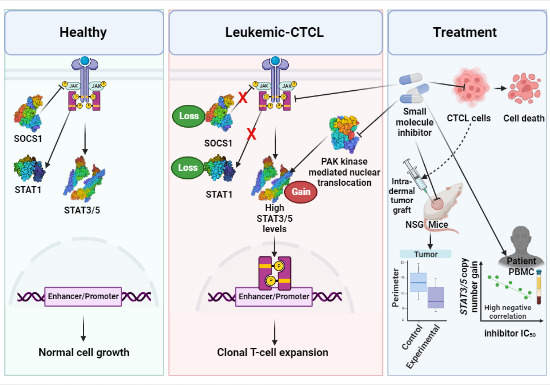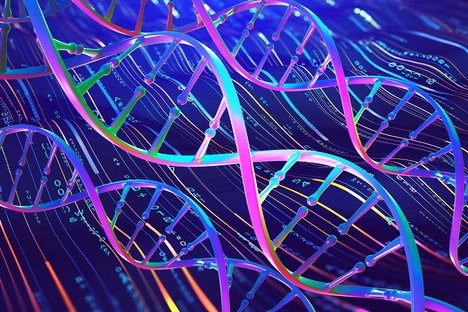博文
多国合作研究确定了白血病皮肤T细胞淋巴瘤的新治疗靶点
||
多国合作研究确定了白血病皮肤T细胞淋巴瘤的新治疗靶点
诸平
据奥地利维也纳医科大学(Medical University of Vienna, Austria)2022年12月15日报道,奥地利研究小组确定了白血病性皮肤T细胞淋巴瘤的新治疗靶点(Austrian research team identifies new therapeutic target for leukemic cutaneous T-cell lymphoma)。
白血病性皮肤T细胞淋巴瘤 (Leukemic cutaneous T-cell lymphoma简称L-CTCL) 是一种罕见的皮肤癌,具有多种临床特征和症状。在奥地利维也纳兽医大学(University of Veterinary Medicine Vienna简称Vetmeduni Vienna)、维也纳医科大学(Medical University of Vienna)、奥地利格拉茨医科大学(Medical University of Graz, Austria)的研究人员,与来自加拿大、德国及英国的研究人员合作,于2022年11月7日已经在《EMBO分子医学》(EMBO Molecular Medinine)杂志网站发表的一项研究中,研究人员设法将受影响患者的基因组数据与药理学研究相结合。这种创新的研究方法已导致将STAT3/5和PAK 激酶(PAK kinase)鉴定为潜在的新治疗靶点。详见:Helena Sorger, Saptaswa Dey, Pablo Augusto Vieyra-Garcia, Daniel Pölöske, Andrea R Teufelberger, Elvin D de Araujo, Abootaleb Sedighi, Ricarda Graf, Benjamin Spiegl, Isaac Lazzeri,Till Braun, Ines Garces de los Fayos Alonso, Michaela Schlederer, Gerald Timelthaler, Petra Kodajova, Christine Pirker, Marta Surbek, Michael Machtinger, Thomas Graier, Isabella Perchthaler, Yi Pan, Regina Fink-Puches, Lorenzo Cerroni, Jennifer Ober, Moritz Otte, Jana D Albrecht, Gary Tin, Ayah Abdeldayem, Pimyupa Manaswiyoungkul, Olasunkanmi O Olaoye, Martin L Metzelder, Anna Orlova, Walter Berger, Marion Wobser, Jan P Nicolay, Fiona André, Van Anh Nguyen, Heidi A Neubauer, Roman Fleck, Olaf Merkel, Marco Herling, Ellen Heitzer, Patrick T Gunning, Lukas Kenner, Richard Moriggl, Peter Wolf. Blocking STAT3/5 through direct or upstream kinase targeting in leukemic cutaneous T-cell lymphoma. EMBO Molecular Medinine, 7 November 2022, 14(12): e15200. DOI: 10.15252/emmm.202115200. https://www.embopress.org/doi/full/10.15252/emmm.202115200
参与此项研究的除了来自奥地利维也纳兽医大学、维也纳医科大学、格拉茨医科大学的研究人员之外,还有来自奥地利因斯布鲁克医科大学(Medical University of Innsbruck, Austria)、奥地利格拉茨的Cbmed股份有限公司医学生物标志物研究中心(CBmed GmbH Center for Biomarker Research in Medicine, Graz, Austria)以及奥地利格拉茨BioTechMed公司(BioTechMed Graz, Graz, Austria);德国莱比锡大学(University of Leipzig, Germany)、德国科隆大学(Cologne University, Germany)、德国曼海姆大学医院(University Hospital Mannheim, Germany)、德国维尔茨堡大学医院(University Hospital Wuerzburg, Germany);加拿大多伦多大学密西沙加分校(University of Toronto Mississauga, ON, Canada)以及英国伦敦的Janpix公司(Janpix, a Centessa Company, London, UK)的研究人员。
尽管进行了大量的基因组测序工作,但迄今为止尚未发现L-CTCL的特征性驱动突变。然而,众所周知,染色体丢失和增加在L-CTCL中很常见且占主导地位。为了获得对该疾病病因的新见解并确定可能的新治疗靶点,研究团队采用了一种新方法:在他们发表于《EMBO分子医学》的研究中,研究团队将基因组分析与药理学干扰研究相结合,以确定导致此疾病的关键突变,从而探索新的治疗方法。
PAK抑制剂FRAx597抑制肿瘤生长和疾病传播(PAK inhibitor FRAx597 inhibits tumour growth and disease dissemination)
来自维也纳兽医大学功能性癌症基因组学系(Department of Functional Cancer Genomics at Vetmeduni Vienna)和维也纳医科大学儿科和青少年外科系(Department of Pediatric and Adolescent Surgery at MedUni Vienna)的上述论文第一作者海伦娜·佐尔格(Helena Sorger)解释道:“在研究的74% L-CTCL患者中,我们检测到含有STAT3/5致癌基因的位点拷贝数增加,这与血液中T细胞计数增加相关。通过使用多激酶阻断剂(multikinase blockers)特异性抑制STAT3/5和PAK激酶,我们能够在体外(in vitro and ex vivo)阻止L-CTCL细胞生长。我们特别高兴的是,我们还能够阻止基因组显示STAT3/5增益的患者的L-CTCL细胞的肿瘤生长。”PAK抑制剂FRAx597在小鼠实验中通过抑制肿瘤生长和疾病传播证明了令人鼓舞的体内抗白血病活性。“我们得出结论,STAT3/5和PAK激酶相互作用代表了一种新的治疗方法,需要在L-CTCL中进一步探索,”海伦娜·佐尔格谈到该研究有希望的结果时说道,这为新的治疗方案指明了道路。
具有不同临床特征的罕见皮肤癌(Rare form of skin cancer with varied clinical features)
皮肤 T 细胞淋巴瘤 (Cutaneous T-cell lymphoma简称CTCL)代表一组异质性非霍奇金淋巴瘤(non-Hodgkin lymphomas),其特征是肿瘤性成熟T细胞主要在皮肤中浸润和扩张。在L-CTCL中,T细胞淋巴细胞(在健康人体内是身体免疫系统的重要组成部分)会出现异常,从而攻击皮肤。
本研究得到奥地利科学基金(Austrian Science Fund:FWF - W1241; grant SFB F04707-B20, SFB-F06105)、René Touraine-Celgene基金会(Foundation René Touraine-Celgene)、欧洲皮肤病学和性疾病学会(European Academy of Dermatology and Venereolog)、奥地利国家银行周年纪念基金(Österreichische Nationalbank Anniversary Fund: grant #15463)以及欧洲肿瘤研究学会(European Association for Cancer Research简称EACR:fellowship #741)的直接或者间接资助。
上述介绍,仅供参考。欲了解更多信息,敬请注意浏览原文或者相关报道。
Leukemic cutaneous T-cell lymphomas (L-CTCL) are lymphoproliferative disorders of skin-homing mature T-cells causing severe symptoms and high mortality through chronic inflammation, tissue destruction, and serious infections. Despite numerous genomic sequencing efforts, recurrent driver mutations have not been identified, but chromosomal losses and gains are frequent and dominant. We integrated genomic landscape analyses with innovative pharmacologic interference studies to identify key vulnerable nodes in L-CTCL. We detected copy number gains of loci containing the STAT3/5 oncogenes in 74% (n = 17/23) of L-CTCL, which correlated with the increased clonal T-cell count in the blood. Dual inhibition of STAT3/5 using small-molecule degraders and multi-kinase blockers abolished L-CTCL cell growth in vitro and ex vivo, whereby PAK kinase inhibition was specifically selective for L-CTCL patient cells carrying STAT3/5 gains. Importantly, the PAK inhibitor FRAx597 demonstrated encouraging anti-leukemic activity in vivo by inhibiting tumor growth and disease dissemination in intradermally xenografted mice. We conclude that STAT3/5 and PAK kinase interaction represents a new therapeutic node to be further explored in L-CTCL.

L-CTCL remains a poorly understood rare T-cell cancer entity. Frequently amplified STAT3/5 oncogenes and related kinase action relevant for T-cell survival were identified as vulnerable nodes for targeting, thereby improving the prospects of a translatable targeted drug for L-CTCL.
- Copy number gain of STAT3/5, which frequently co-occurs with loss of STAT1 and SOCS1, contributes to increased clonal expansion in leukemic cutaneous T-cell lymphoma.
- STAT3/5 can be blocked directly or indirectly, through upstream kinase inhibition, particularly involving PAK-mediated STAT3/5 nuclear translocation.
- PAK kinase inhibition is selective for L-CTCL patient cells carrying STAT3/5 gains and reduces growth of intradermally xenografted tumors.
The paper explained
Leukemic forms of cutaneous T-cell lymphomas (L-CTCL) are lymphoproliferative disorders of skin-homing mature T-cells, for which oncogenic drivers and key chromosomal rearrangements relating to disease progression remain elusive. Current therapies lead to abysmal and often short-lived responses. Given the struggle that L-CTCL patients face due to high symptomatic burden, inefficient treatments, and considerable mortality, we explored novel targeted therapy options.
STAT3/5 copy number gains were present in 74% (n = 17/23) of L-CTCL patients and correlated with disease clonality. Targeting the resulting STAT3/5 overexpression and hyperactivation using novel specific small-molecule degraders and (multi)kinase blockers resulted in cell death, whereby PAK kinase inhibition was specifically effective in patient cells carrying STAT3/5 gains. Furthermore, PAK kinase inhibition induced significant decreases in tumor size and CTCL cell dissemination in an intradermal xenograft mouse model.
The highly frequent STAT3/5 copy number gains in L-CTCL, which result in STAT3/5 overexpression and hyperactivation, might serve as a novel marker for treatment guidance and disease monitoring. Further development of the characterized STAT3/5 degraders and improvement of lead structure IQDMA/PAK kinase inhibitors should be continued in the search for curative targeted drugs.
https://wap.sciencenet.cn/blog-212210-1368158.html
上一篇:新工艺提升双面CIGS薄膜太阳能电池效率
下一篇:二甲双胍需要细胞应激反应蛋白的作用才能发挥作用
